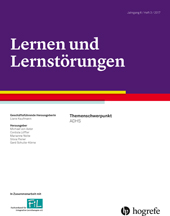ADHS Spektrum
Abstract
Zusammenfassung. Die Aufmerksamkeitsdefizit-/Hyperaktivitätsstörung (ADHS) ist die wohl am häufigsten diagnostizierte Verhaltensstörung im Kindes- und Jugendalter. Dieser Artikel beschreibt das diagnostische Vorgehen in der Praxis und die verschiedenen Behandlungsschritte, thematisiert aber auch die Widersprüchlichkeiten und Unstimmigkeiten rund um dieses komplexe Störungsbild. Unsicherheiten entstehen vor allem darum, weil es kein allgemein anerkanntes Störungsmodell gibt, kein zuverlässiger ADHS-Test zur Verfügung steht, sich die Störung mit anderen Erkrankungen zum Teil erheblich überschneidet und vor allem weil ADHS Symptome kontinuierlich in der Population verteilt sind, was die Diagnose von den Erwartungen des Umfeldes und den gesellschaftlichen Bewertungen abhängig macht. Dieser Artikel schlägt in Anlehnung an die Autismus Spektrum Störung deshalb den Begriff ADHS Spektrum vor. Diese passende Bezeichnung berücksichtigt neben den dimensionalen Eigenschaften von ADHS auch deren grosse Heterogenität.
Abstract. Attention-deficit/hyperactivity disorder (ADHD) is one of the most common neurodevelopmental disorders in childhood and adolescence. This article highlights the diagnostic procedures in clinical practice and the different treatment modalities, but also focuses on the inconsistencies and dilemmas of this complex and heterogeneous disorder. Uncertainties arise because there is no generally accepted etiological model and no reliable test for the individual patient. Furthermore, a large overlap exists with other neurobehavioral disorders, and finally, ADHD symptoms are continuously distributed in the normal population, which make the diagnosis dependent on environmental expectations and societal judgment. Thus, this article proposes rather to use the term ADHD spectrum, which not only considers the dimensional nature of ADHD, but also its heterogeneity and complexity.
Literatur
American Psychological Association (2013). Diagnostic and statistical manual of mental disorders. Washington, DC.(1997). “Behavioral inhibition, sustained attention, and executive functions: constructing a unifying theory of ADHD.”Psychol Bull 121(1), 65–94.
(2013). Lehrbuch Klinische Paar- und Familienpsychologie. Bern: Verlag Hans Huber.
(1984). Origins and Evolution of Behavior Disorders. New York: Brunner/Mazel.
(2012). “Annual research review: categories versus dimensions in the classification and conceptualisation of child and adolescent mental disorders--implications of recent empirical study.”J Child Psychol Psychiatry 53(5), 469–489.
Cross-Disorder Group of the Psychiatric Genomics Consortium (2013). Identification of risk loci with shared effects on five major psychiatric disorders: a genome-wide analysis. Lancet, 381, 1371–1379.(2006). Aufmerksamkeitsdefizit-Hyperaktivitätsstörungen. Kinderdiagnostiksystem (KIDS). Göttingen: Hogrefe.
(2007). “Perceptions of academic skills of children diagnosed with ADHD.”J Atten Disord 10(4), 390–397.
(2014). “Evidence-based psychosocial treatments for children and adolescents with attention-deficit/hyperactivity disorder.”J Clin Child Adolesc Psychol 43(4), 527–551.
(2006). “The age-dependent decline of attention deficit hyperactivity disorder: a meta-analysis of follow-up studies.”Psychological Medicine, 36, 159–165.
(2006). “Comparing the efficacy of medications for ADHD using meta-analysis.” MedGenMed, 8(4), 4.
(2011). “Associations between problems with crying, sleeping and/or feeding in infancy and long-term behavioural outcomes in childhood: a meta-analysis.”Arch Dis Child, 96(7), 622–629.
(2011). „Wenn die kindliche Entwicklung nicht im Gleichschritt verläuft – Kinder mit Entwicklungsauffälligkeiten besser verstehen.“Pädiatrie up2date, 2, 199–228.
(1973). “Minimal brain dysfunction as a neurodevelopmental lag.”Ann N Y Acad Sci, 205, 268–273.
(2012). “The decisions regarding ADHD management (DRAMa) study: uncertainties and complexities in assessment, diagnosis and treatment, from the clinician’s point of view.”Eur Child Adolesc Psychiatry, 21(2), 87–99.
(2010). “Mapping of cortical activity in the first two decades of life: a high-density sleep electroencephalogram study.”J Neurosci, 30(40), 13211–13219.
(2014). “Attention-deficit/hyperactivity disorder in young children: predictors of diagnostic stability.”Pediatrics, 133(4), 659–667.
(2016). “Stigmatization of ADHD: A Developmental Review.”J Atten Disord, 20(3), 199–205.
(2011). “Does Attention-Deficit/Hyperactivity Disorder Have a Dimensional Latent Structure? A Taxometric Analysis.”Journal of Abnormal Psychology, 120(2), 427–442.
(2015). “Is Adult ADHD a Childhood-Onset Neurodevelopmental Disorder? Evidence From a Four-Decade Longitudinal Cohort Study.”Am J Psychiatry, 172(10), 967–977.
(2012). “Influence of relative age on diagnosis and treatment of attention-deficit/hyperactivity disorder in children.” CMAJ, 184(7), 755–762.
(2008). “Public knowledge and assessment of child mental health problems: findings from the National Stigma Study-Children.”J Am Acad Child Adolesc Psychiatry, 47(3), 339–349.
(2007). “Practice parameter for the assessment and treatment of children and adolescents with attention-deficit/hyperactivity disorder.”J Am Acad Child Adolesc Psychiatry, 46(7), 894–921.
(2007). “The worldwide prevalence of ADHD: a systematic review and metaregression analysis.”Am J Psychiatry, 164(6), 942–948.
(2013). “Topography of sleep slow wave activity in children with attention-deficit/hyperactivity disorder.”Cortex, 49(1), 340–347.
(2014). “Neurobiological measures to classify ADHD: a critical appraisal.”Eur Child Adolesc Psychiatry, 23(5), 243–246.
, (2007). “Attention-deficit/hyperactivity disorder is characterized by a delay in cortical maturation.”Proc Natl Acad Sci USA, 104(49), 19649–19654.
(2011). “Cortical development in typically developing children with symptoms of hyperactivity and impulsivity: support for a dimensional view of attention deficit hyperactivity disorder.”Am J Psychiatry, 168(2), 143–151.
(2013). “Nonpharmacological interventions for ADHD: systematic review and meta-analyses of randomized controlled trials of dietary and psychological treatments.”Am J Psychiatry, 170(3), 275–289.
(2002). “Psychological heterogeneity in AD/HD – a dual pathway model of behaviour and cognition.”Behavioural Brain Research, 130(1–2), 29–36.
(2014). „Neurobiologische Grundlagen der Aufmerksamkeitsdefizit-/Hyperaktivitätsstörung.“ Fortschr Neurol Psychiatr, 82(1), 9–29.
Weltgesundheitsorganisation WHO (2014). Internationale Klassifikation der Krankheiten (ICD-10-GM).(2011). “ADHD: clinical practice guideline for the diagnosis, evaluation, and treatment of attention-deficit/hyperactivity disorder in children and adolescents.”Pediatrics, 128(5), 1007–1022.
(2012). “Childhood ADHD is strongly associated with a broad range of psychiatric disorders during adolescence: a population-based birth cohort study.”Journal of Child Psychology and Psychiatry, 53(10), 1036–1043.



